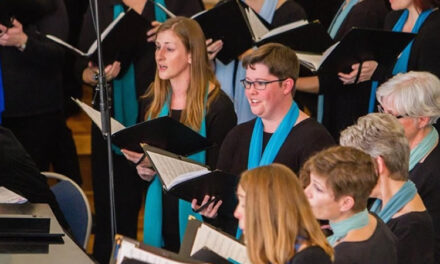Claude Debussy, En blanc et noir, Olivier Messiaen, Visions de l’Amen; Ursula Oppens & Jerome Lowenthal, pianos (Steinway) 1 & 2; Çedille CDR 90000 119, ©2010, 60:51, $16.00.
Both of these works were composed in wartime, the Debussy early in WW I in 1915 and the Messiaen in the middle of WW II in 1943. Everyone knows that Messaien was directly impacted by the war since he was held in an internment camp for eight months, during which time he composed the unforgettable Quatuor pour la fin du temps. Debussy regretted being unable to serve because of his age and health – he was undergoing treatment for the cancer that took his life at the time, but he had many friends who did serve, so he was affected differently and indirectly. It is interesting to see, or rather hear, how the impacts of the wars on them are manifested in the works.
We all know that Messiaen’s passions were his Catholic Christian faith and birdsong, and that both find their way into nearly every one of his compositions in one way or another, including this one, whose fifth movement (of seven; the central one, “Amen du désir,” is the longest, the sixth, “Amen du jugement,” the shortest) is entitled: “Amen des anges, des saints, et du chant des oiseaux.” We also all associate Debussy with atmospheric Impressionism and with childhood playfulness, but this work demonstrates neither. Its three movements are very diverse, but all feature things breaking or broken up into fragments. Each has an epigraph from French poetry and a dedicatee: Serge Koussevitzky, Jacques Charlot, an associate of his (also Messiaen’s) publisher Durand who was an early victim of the war, and Igor Stravinsky, respectively. The first is a waltz that in some ways foreshadows Ravel’s La Valse of 1919-20 (of which he also made a 2-piano version). The second, the longest, marked “Lent, Sombre,” is dark, features clashes of melodies: Luther’s Ein feste Berg and a carillon-like one that suggests La Marseillaise, and has moments that evoke an unstoppable machine, bringing to mind Pacific 231 of 1923 by Arthur Honegger. The third features melodies begun but seemingly left hanging, incomplete, unresolved, with some dissonance. Messiaen sublimated his feelings into mystical meditations some of which are very abrasive, harsh, loud, shattering, sonorous, and strident, not the kind of atmosphere the term ‘meditation’ brings to mind. Its first movement, “Amen de la Création” is a long crescendo not unlike Ravel’s Boléro, though less rhythmically propelled, that evokes the formation of the universe out of nothingness. There are other sublimely calm and silent moments besides this movement’s opening as well, making for an enormous and sometimes disturbing range of sound and emotion.
This duo has performed together in public before, but this is its first recording. A revealing biographical detail for Lowenthal is that his other duo partners were/are his late wife, Ronit Amir, and their daughter Carmel Lowenthal. No wonder the performance is so seamless that the listener often feels it’s a single instrument and performer! Indeed, the communication is not unlike that in the 1962 recording by Messiaen (piano 2 – no information about the pianos, but they do not sound like Steinways to my ears) and his second wife, Yvonne Loriod (piano 1 – note the gender parallelism), who gave a private première of the work (at which Honegger was present) the day before the public one (9 & 10 May 1943 respectively; Loriod was then Messiaen’s pupil), that is nearly a minute longer and has detailed program notes by the composer that are in places as staccato-like as much of the music. Oppens earlier played duos with Paul Jacobs (who played the Debussy with Gilbert Kalish) and Frederick Rzewski.
Lowenthal is the author of the fine program notes in the accompanying booklet. They are followed by one-page bios of each of the pianists. The credits are on the inside of the front cover with the track listings and timings on the facing page three. The June 2009 recording venue was the Academy of Arts and Letters in NYC, and the engineer and producer was multiple Grammy Award-winner Judith Sherman. This accounts for the flawless and remarkable sound. The booklet’s black front cover with text mostly in white reproduces a photo of a striking plaster bust by Auguste Privat (in a private collection), “Prayer,” showing only white hands and face that consequently suggests a nun. A color photo of the duo appears on the outside of the tray card. As usual with Çedille CDs, this is a simple but ‘classy’ production, in spite of the misspelling of Honegger and a couple other minor textual errors.
Lowenthal’s bio says that he encourages his students to: “understand the music they play in a wide aesthetic and cultural perspective – and to project it with the freedom that perspective allows.” This perspective appears to have informed this pairing. There are at least 20 other recordings of En blanc et noir and about the same number of Visions de l’Amen currently on the market, and others that no longer are (including some that I own, such as the aforementioned one of Visions…), but not a one of the approximately half of those for the Debussy and a fifth of those for the Messiaen that are not single-composer products pairs them. This recording offers, therefore, in addition to the pleasure of the impressive pianism, a unique and enlightening perspective.











